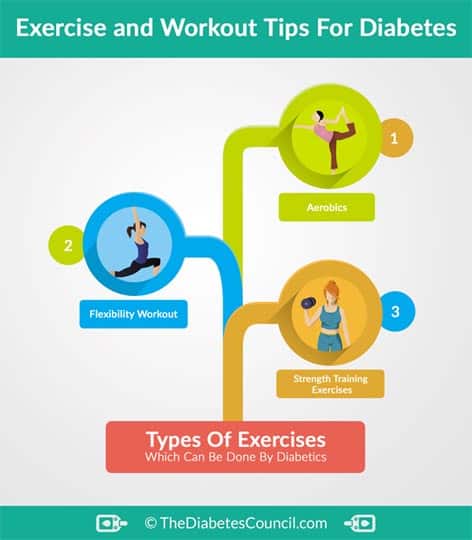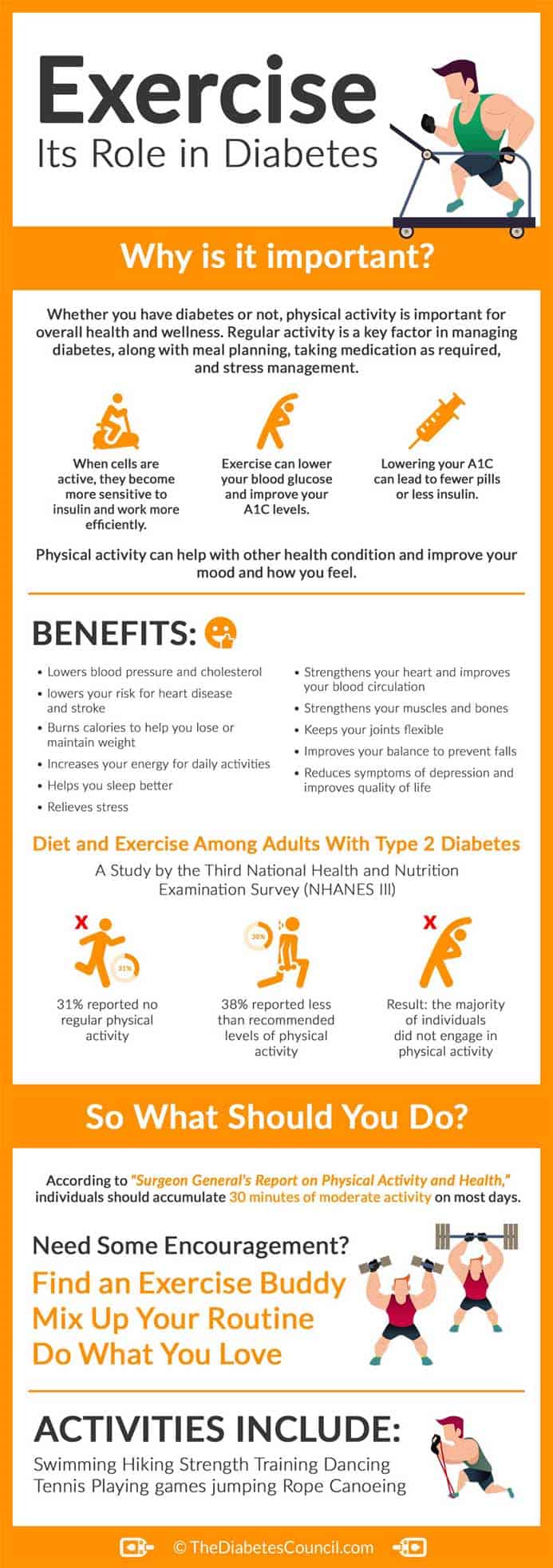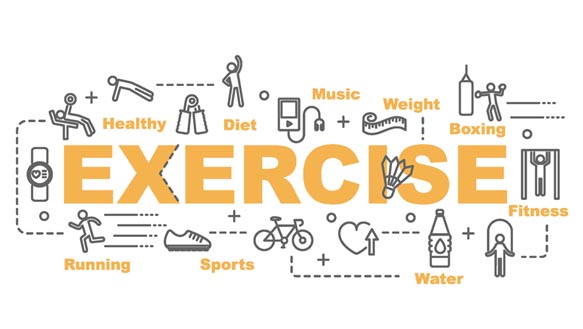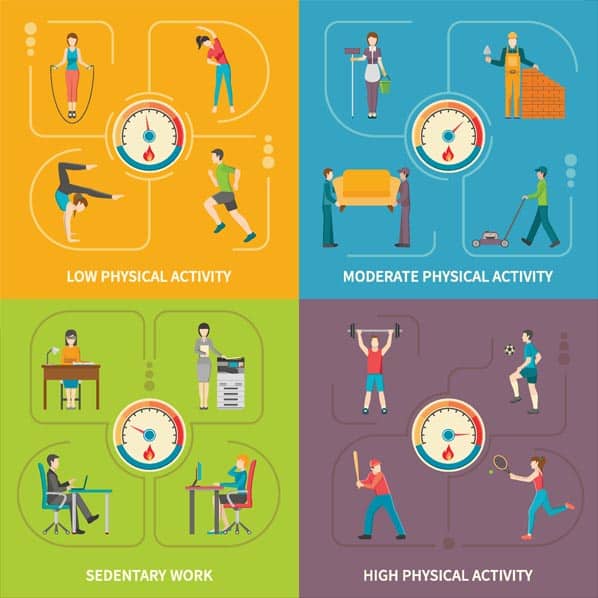
Physical activity is such an amazing thing for people to partake in, especially if they have a chronic illness such as diabetes.
Unfortunately, though, only 39% of people that have diabetes participate in regular exercise compared to the 58% of people without diabetes that exercise regularly.
This article explains the precautions that you should take while exercising with diabetes, as well as different types of exercise and why they are so beneficial.
Before you do anything, talk to your doctor to find out which activities are safe.
In order to be safe, always talk to your doctor before beginning any exercise program. There are many limitations that your doctor may have for you because of your diabetes or because of other diseases or complications that you may have.
According to the NIDDK, people with diabetes who are overweight should combine physical activity with a calorie deficit meal plan. People who moved a lot and ate less had long term health benefits compared to those who do not make the appropriate changes in their lifestyle.
Contents
Why is exercising good for people with diabetes?
Exercise is great for anybody, but especially for people with diabetes. Some of the great benefits that it provides include:
- Decreasing your risk of depression
- Increasing your quality of sleep
- Lowering blood pressure
- Helping to control your weight
- Decreasing the risk of heart disease
- Reducing stress
- Making cells more sensitive to insulin
- Burning off extra glucose that is in the bloodstream
- Lessens the risk of complications such as kidney disease, stroke, and eye problems
Exercising reduces the risk of developing a major chronic illness by 50% and cuts the risk of an early death by up to 30%. The benefits are so incredible, yet some people still refuse to participate in any physical activity.
Blood sugar and exercise
When you exercise, your body burns more glucose than it would normally if you were being inactive. This is a good thing because it lowers your blood sugar, but it can also be dangerous and lead to your blood sugar becoming too low. Understanding how your blood sugar changes before, during, and after exercise is key to preventing problems and maximizing the benefits.
Before exercising
Always check your blood sugar before you begin exercising. There are two important reasons for this. If it is too low, then you should eat a snack that is high in fiber and complex carbohydrates to increase your sugar since you will be burning off glucose. If it is too high, you want to wait until it is a normal number to prevent it from becoming even higher.
During exercise
Be sure that you stay hydrated while you are exercising. If you are active for a long period of time, it is important to check your blood sugar after 1 hour of exercise to make sure that you don’t need a snack. If you have type 1 diabetes, it is a better idea to check your sugar after 30 minutes o physical activity. The higher the intensity of the exercise, the higher the risk of hypoglycemia. For example, 30 minutes of walking is less of a risk than 30 minutes of a kick-boxing class.
If at any time while you are exercising you have signs of low blood sugar, be sure to slow down, and eventually stop the activity. Check your blood sugar to make sure that it has not become too low and eat a snack if it is needed.
After exercising
After exercising is another important time you should check your blood sugar. It can continue to drop after you finish exercising for 24 to 48 hours. It is very important for you to check your blood sugar regularly and to be aware of the risk than it can drop. Be careful before giving yourself any insulin after you have exercised if you aren’t going to eat immediately. Also, exercising too close to bed can be dangerous. If your blood sugar drops while you are sleeping, you may not be aware.
On the other hand, exercise can cause some people’s blood sugar to increase. Don’t be alarmed if this happens to you, just be aware and manage it appropriately.
Always have carbs with you
If there is a risk of your blood sugar dropping, it is imperative that you have carbohydrates with you at all times.15 grams of carbohydrates is the recommended amount for a good snack.
Great examples of this are:
- A small apple
- 1 cup of raspberries
- 2.5 ounces of peanuts
- 1 slice of bread with peanut butter
- 3 cups of raw broccoli
If you are not planning on eating anything else for a few hours, be sure that your snack not only contains 15 grams of carbohydrates, but that it also has 7 grams of protein to keep you full and fueled.
Don’t go hard right away.
Take it slowly!
It is very important for you to include a warm-up when you start exercising. Stretching is also very important to prevent hurting yourself. This gives your muscles and your heart a chance to get warm and ready to exercise. When you are finished exercising, you should slow down before quickly stopping. This gives your heart a chance to slow down and for you to catch your breath safely.
When you begin a different type of exercise, such as jogging or biking, you should also start slow. Don’t try to do something similar to a friend that has been running for 3 years. Give your body time to work up to the exercise so that you don’t get injured or too sore that you never try it again.
Experts recommend 30 minutes, 5 days a week of moderate or vigorous physical activity. To lose weight, you will have to invest 60 minutes, 5 times a week of physical activity. It is important to plan with your health care team before you start on your journey of a new exercise routine.
Things to consider during activities
There are some red flags that should definitely concern you if they occur while you are exercising. They include:
- Feeling faint or dizzy
- Feeling nauseated during or after activities
- Chest pains or chest tightness
- Shortness of breath
If you do experience any of these, you should slow down for a few minutes and then stop exercising. Abruptly stopping can be harmful to you and actually cause more problems. Sit down, get a drink, and check your blood sugar. If your blood sugar is low, eat a snack. If these problems persist, call your doctor or 911, depending on the severity. It is important that you tell the person that you are with the symptoms that you are experiencing in case you lose consciousness.
Precautions to take when it comes to exercise
There are a few things for people with diabetes to be aware of while they are exercising that can cause a problem.
Hypoglycemia
One of the most common problems is low blood sugar. Since your body is burning more glucose, it is possible for it to burn too much. This risk is even higher if you take medications for your diabetes or insulin. Be sure that you don’t exercise while you are ill, because sickness such as the flu can make your blood sugar very hard to control. It is important that you inform the people that you are exercising with that you have diabetes, and always pack a snack with you.
Hyperglycemia
If your blood sugar is higher than 240 before you exercise, then you need to wait for it to decrease before you try to do any physical activity. Exercise releases hormones which can cause your blood sugar to rise even higher, putting you at a risk of developing diabetic ketoacidosis.
Foot problems
Diabetes can cause circulation problems which leads to poor wound healing. If you have shoes that do not fit properly, then you could cause a very serious wound. I have a friend that actually lost his toe because of a blister that was caused by an ill-fitting shoe that he wore one time.
Ways that you can prevent problems with your feet are:
- Always wear shoes when exercising
- Wear cotton socks that will absorb any moisture
- Buy specially made shoes at a diabetic supply store
- Check your feet daily for sores or areas where your shoe could be rubbing your foot
I recommend reading the following informative articles:
Heart problems
If you already have heart problems, then your risk of worsening them with exercise is greater. You want to avoid any physical activity that causes chest pain or that requires you to get up quickly. If you have heart disease, it is very important to talk to your doctor about your exercise plan before beginning.
Eye problems
If you have retinopathy, you want to avoid exercises that put extra pressure on the eyes. That includes straining or heavy lifting. Cataracts and poor vision are complications of diabetes that can make balance an issue and increase your risk of falls. Be sure that you use caution and exercise safely.
Neuropathy
Neuropathy is a very common complication of diabetes. If you have decreased sensation in your feet, use extra care and take it easy on your feet. Your balance can be difficult, so it is important that you are careful not to fall. Also, stepping on things while walking can be an issue since you may not feel anything go through your shoe into your foot, such as a nail.
The NIDDK recommends the following activities for people with diabetes: aerobic exercises, strength training, stretching. Some people who cannot perform any of the previously mentioned activities may choose to walk.
A recent study proposes jogging, cycling, swimming as different types of aerobic activities that can be performed. Aerobic activities increase insulin sensitivity, oxidative enzymes, lung and immune function, etc. It is important that people with diabetes decrease the amount of time spent in sedentary mode.
Which types of exercise are beneficial for those with diabetes?
Different types of exercise are great for those with diabetes because they each have their own benefits. It is important to switch it up when exercising. If you need more support on how to build a great exercise plan, find an exercise physiologist in your area. You can read an article that I wrote about how they can be beneficial here: https://www.thediabetescouncil.com/can-exercise-physiologist-help-diabetes/
Walking
Walking is a great way to begin to exercise journey. It is easy on your joints, free, and it can be done anywhere. It is recommended that you do 30 minutes 5 to 6 days a week. If you need to, break this 30 minutes up into three 10 minute sessions throughout the day. Walk before work, during lunch, and then in the evening after dinner. Walking is helps in burning calories and losing extra weight and also increases the health of your heart.
Aerobic exercise
Aerobic exercise is anything that makes your heart rate increase and causes you to sweat. It can be a variety of things such as group activities, sports, walking at a brisk pace, or jogging. Just like walking, if you are able to participate in aerobic exercises, it is recommended that you do them 30 minutes 5 to 6 days a week. This is done instead of walking, not in addition to. It depends on your fitness level.
Strength training
Strength training is great for those with diabetes. Things such as weight training, pull-ups, and push-ups increase your muscle mass. This is beneficial because muscles use most of the glucose, which can help you lower your blood sugar. Strength training is recommended for 20 to 30 minutes 2 to 3 times a week. Be sure that you take days in between to do either aerobic exercise or another type of exercise to give your muscles times to recover. You should do 5 to 10 different types using the different major muscle groups. It is best to do 3 or 4 sets with 10 to 15 reps in each set. You may have to work our way up to that, and it is okay!
It is very important that you are aware how to safely do any exercises or use any equipment to prevent injuring yourself. If you join a gym, there should be a physical trainer that will show you how to properly use the exercise machines. For some people that don’t like the gym, you can buy DVD’s to watch at home, or you can even find free videos on the internet.
Yoga, Pilates, and Tai Chi
These types of exercise are great for people with diabetes. Not only do they decrease stress and reduce depression, but they lower body fat, improve nerve communication, and there is no limit as to how much you can do. You can probably find classes in your area, or if you are nervous about it, you can buy videos and do it in the privacy of your own home.
For more information read these articles:
Add extra activity routines to your day
A great way to burn extra calories and add more movement to your day is to add activity where you typically would be sedentary. Although this doesn’t count as your daily exercise, it’s a great way to keep active.
Some super easy ways are:
- Walk around when you are on the phone. You can easily go outside and take a stroll through the neighborhood while you are talking.
- Do chores around the house to keep moving. You can involve your kids with this one. We have “dance clean-up parties” in our house where you have to keep dancing the entire time you are cleaning your room. Not only is it active, but it brings a smile to your face.
- Do a few exercises during commercial breaks while watching television. All it takes is 5 push-ups or 10 squats. They add up and can really make a difference.
- Take the stairs instead of an elevator. Stairs are great for your muscles as well as your heart. Make sure you use the hand rail and rest if you get short of breath.
- Go for outings with friends and family that are active instead of just a meal. Go hiking or walking at a park in place of meeting for coffee.
- If you are sitting too long in one place, get up once in a while and stretch. If you have a desk job, get up every 3o minutes or so and do a few minutes of squats or walk around. Sitting for too long isn’t good for your circulation or your heart.
Recommendations on the types of exercises you can perform may vary on the type of diabetes you may have, your age, the activity itself, presence of diabetes complications and what your eating lifestyle is.
Make activities fun
If you are on an exercise program that you don’t enjoy, chances are you aren’t going to stick with it. Find something that you really like to do. If it feels like a chore, then don’t do it. There are many different ways to exercise for you to settle on something that you don’t like to do. If you haven’t found what it is that you like to do, then try different things until you find your niche. You may be surprised at what you enjoy.
When you are exercising, go with a friend or a family member. Take your entire family to the park and play a game of tag or basketball. Not only are you exercising, but you are teaching your kids or grandkids good habits while having fun with them. If you walk in your neighborhood, try to find a neighbor that likes to walk too. Just having the company can make the time pass much more quickly, plus it is always safer to exercise with someone else.
Disclaimer: discuss with your doctor before you start any new activity
Like I mentioned at the beginning of this article, please talk to your doctor before starting any new exercise plan. They know what is safe for you and what is not. Be sure to be specific with them about your plan, so that they knows the associated risks. For example, don’t tell them you want to start hiking, when you are actually planning on taking a 3 day trip up to the top of a mountain.
Exercise is a great benefit for anyone, but especially for those with diabetes. Be safe, enjoy yourself, and learn how to make a lifestyle change for the better. Remember to post and share your thoughts in the comments below.
TheDiabetesCouncil Article | Reviewed by Dr. Sergii Vasyliuk MD on June 01, 2020
References:
- https://www.ghc.org/healthAndWellness/?item=/common/healthAndWellness/conditions/diabetes/exercisePrecautions.html
- https://www.endocrineweb.com/conditions/type-2-diabetes/type-2-diabetes-exercise
- http://www.diabetesforecast.org/2012/jul/endurance-sports-and-diabetes-management.html
- https://www.sharecare.com/health/diabetes/slideshow/best-exercise-for-diabetes











